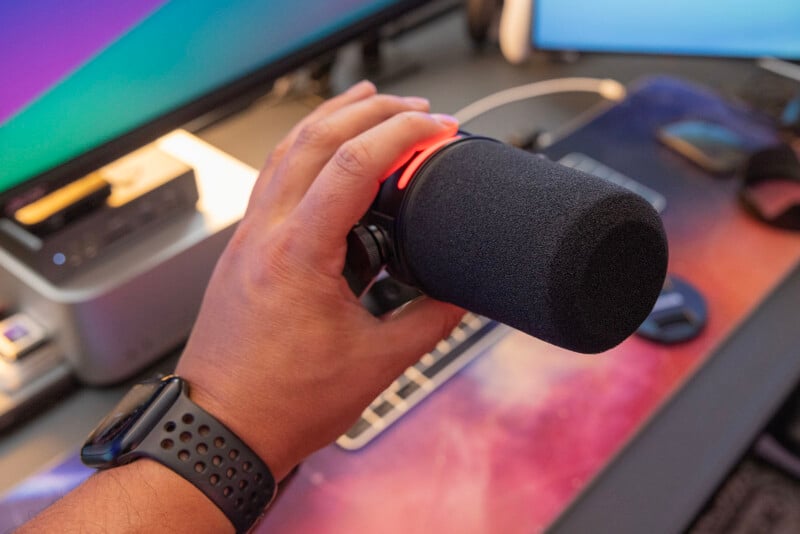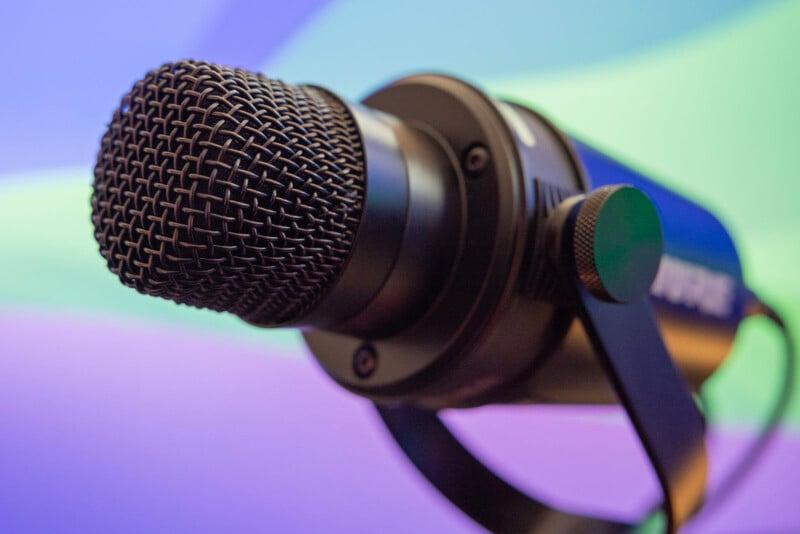Shure MV7+ Review: The Best Studio Mic for Most People
![]()
I’ve used a lot of different microphones over the past few years, but recent experience with Shure on The PetaPixel Podcast put its SM7db at the top of my tier list. Shure’s new MV7+ doesn’t quite unseat my number one favorite mic, but it comes darn close.
Shure launched the $279 MV7+ in early April and positioned it as a significant step forward over the MV7 it replaces. It’s also meant to be more approachable to the average user than the SM7db launched last year because it comes with additional software features that make it easier to use in “more challenging” spaces and it offers the ability to connect via XLR and USB-C right out of the box — the SM7db is XLR only and requires a dongle to work with USB.
So the MV7+ is smaller, has more software options and a built-in chip to manage them, includes dual connectivity, and is far less expensive. So what’s the catch?
Shure MV7+ Review: Design and Build Quality
Shure didn’t deviate much from its tried-and-true cylinder microphone design, and that’s okay because it works really well. The body of the MV7+ doesn’t cut any corners and uses the same aluminum shell that its more expensive, pro-tier broadcasting microphones do.
![]()
The MV7+ also sets the body of the microphone on a U-shaped holder which lets you easily angle it. That holder attaches to whatever microphone stand you might have and while Shure will eventually sell a desktop stand for it later this year, I recommend you get an arm. During my time with it mounted to a different desktop stand, I found that any light touches against it were picked up by the capsule and it’s difficult to not touch a mic when it’s sitting on your desk. Floating it above that surface will result in more consistent, interruption-free audio.
![]()
The back of the microphone is extremely simple since Shure opted to go with basically full digital control of the mic, a topic we’ll return to momentarily. On the rear of the MV7+ you’ll find just a headphone jack, XLR input, and USB-C input.
The top of the mic features an LED bar that can be customized but it’s also touch sensitive and operates as a mute button. The pulsing LED is clearly meant to appeal to streamers and while I like the idea, the location of this bar is unfortunate: it is very difficult to adjust the angle of the mic without accidentally touching the bar. It’s located basically exactly where it feels natural to grab the mic unless it is oriented with the handle facing up, which isn’t an option for me and, I imagine, would be rare for most users in the market for this mic, too.

Because of this constant issue, I disabled touch entirely which you can, luckily, do.
Overall though, the build quality of the MV7+ is very nice. It’s a hefty, solid-feeling microphone that feels very well made while still managing to be small and easy to transport.
Software Control
There are no hardware controls on the MV7+ as Shure opted to use a digital interface instead. Seeing as the target user is very likely picking the USB-C connection over XLR and Shure created an entirely new desktop app to manage the MV7+, I’m more forgiving of this choice than I otherwise would be.
That said, I do wish that the MV7+ had manual monitor control. I want to be able to adjust volume to my headphones with a physical dial if possible but I do recognize this is not an issue that is found on the MV7+ alone and is more of a Shure design philosophy thing as the SM7db also doesn’t have such a dial.
Before I get into the actual controls, I should first mention the new Motiv Mix desktop app. Motiv Mix is a full digital mixer that also builds in all of the controls previously found in the mediocre Motiv app. While technically still in beta at the time of publication, I’ve had no issues with Motiv Mix at all over the last few weeks and it regularly impresses me with how well it works and how easy it is to use.
![]()
While it works with any input, and especially well with Shure mics where you get all of the options that were available in the Motiv app, accessing the MV7+ through it gives you control over gain, a digital compressor, a digital limiter, a digital pop filter, and a real-time denoiser. The compressor works quite well and keeps your voice at an even volume through an entire recording while the digital limiter keeps you from peaking. The digital pop filter, which Shure calls the “Popper Stopper,” works decently well, but in my experience it can’t quite match the effectiveness of a hardware filter — more on that in the audio section below.
![]()
The app also gives you the ability to tune the volume of the monitor, change the tone of recorded audio, and provides a reverb and high pass filter option — I typically don’t touch those last two.
Finally, the aforementioned LED control can also be found here. You can set it to Live, Pulsing, or Solid color and the brightness can also be toggled. The LED is full RGB and the color can be selected from a few presets but you can also construct your own.
![]()
What I really like about the MV7+ is that any of the settings you adjust here are saved to the mic itself, meaning that once you’ve set it up one time, it will always retain those settings no matter what computer it is attached to and works with both USB or XLR. Being able to set the mic up at home and then travel with it and use it in any environment while knowing it will retain my custom settings is a big win.
Shure MV7+ Review: Audio Quality
The Shure MV7+ sounds very good. Side by side with the far more expensive SM7db, you have to listen very closely to hear any difference. Below is an example of the same audio track recorded to each mic.
This first clip is recorded with the SM7db:
And this second clip was recorded using the MV7+:
Unless you were really listening closely, you would be hard pressed to tell the difference. What I will say is that I still think the SM7db sounds better, but the MV7+ gets 95% of the way there. There is a slightly warmer tone to the SM7db and the physical pop filter works better than the digital one in the MV7+, but that’s about it.
Both of those clips were recorded with the mic the same distance away from my mouth — about six inches — and the more noticeable plosives from the MV7+ recording could be mitigated by moving the mic slightly farther away. However, doing that will leave you more susceptible to reverb from room noise, so some trial and error is necessary.

All that said, the fact of the matter is that the MV7+ sounds fantastic, especially when you consider that it’s $170 cheaper than the SM7db.
You can listen to many more samples from the mic to gauge quality (and how much of an issue echo can become in very empty rooms) by listening to the April 24 episode of The PetaPixel Podcast below.
Listening to that audio, I don’t think the echo is distracting by any means, but I can certainly hear room noise in places that I wish I couldn’t. That’s partially because the room I was in was very susceptible to echo and partially because I kept the mic farther from my mouth to avoid plosives.
The Shure MV7+ is the Best Studio Mic for Most People
I’m honestly shocked how good the MV7+ is compared to the far more expensive SM7db, to the point that I think many creators won’t feel compelled to spend the extra money for the higher-end microphone. Usually there is more of a tradeoff when a product is nearly half the price, but Shure didn’t cut any major corners here.
While there is just slightly less warmth to the MV7+ than the SM7db and the plosive control isn’t as good (and the mute button is now a touch screen I frequently hit by accident), the MV7+ gets you 95% of the way there for much less money. It’s also smaller, lighter, and more versatile thanks to the built-in chip that lets it remember all of your settings and the fact it works with XLR or USB-C. That’s a ton of value with very little downside. Even if you don’t see yourself needing XLR inputs, the fact that they are an option future-proofs you in the case you ever need one.
What you get for the price makes this microphone really compelling.
Are There Alternatives
While the MV7+ is very good, it’s not alone in the quality USB microphone space. If you like how Jordan Drake sounds during our recordings of The PetaPixel Podcast, you’re listening to the $129 Sennheiser Profile USB mic. It’s a very good microphone that has tons of on-board hardware controls, but it requires an additional pop filter to manage distracting plosives and it doesn’t have an XLR input.
The $169 Rode NT-USB+ is also a fantastic microphone for the price as it sounds great, has onboard hardware controls, and comes with a pop filter. This mic is more susceptible to room noise than the MV7+ though, so keep that in mind.
I do think that the MV7+ sounds better and is more customizable than both those alternatives, but it is also easily the most expensive of these three options at $279. You’re paying a premium for more directional audio quality of Shure’s mic combined with the breadth of software controls.
Should You Buy It?
Yes. Shure’s MV7+ comes remarkably close to the high-end quality of Shure’s far more expensive SM7db mic while shrinking down to a more portable form factor, adding USB-C, and adding a bunch of useful software features.